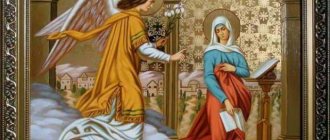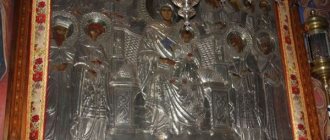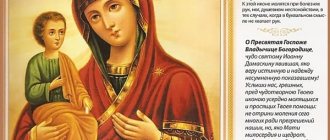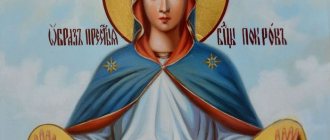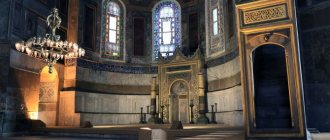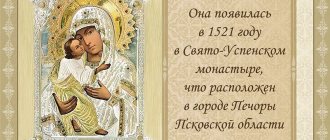Significant for Christians is the icon “Nativity of the Blessed Virgin Mary”, which stands out among other images in that it depicts the earthly life of people. She has enormous power and you can pray before her not only on a holy holiday, but at any other time.
Brief history of the birth of the Mother of God
After many years of prayer, the elderly parents gave birth to a long-awaited child, whose birth was announced to the future father and mother through the angels by God Himself.
An ancient legend says that an extraordinary child sent from Heaven was born into the family of the righteous Joachim and Anna, a descendant of a royal family and the daughter of a high priest, who lived in Nazareth. The couple did not have children for a long time, but having reached old age, they resignedly continued to pray to God to send them a child.
Previously, among Jews it was believed that if there were no children in a family, then the spouses were rejected from God.
One day Joachim prayed for a long time in the desert, and he had a vision of the Archangel Gabriel. He told the prayer book that his request had been heard by God, and that he would soon have a daughter. She will be blessed. Through her salvation will be given to the whole world. The messenger instructed the parents to name the newborn child Mary.
And so it happened, and soon a girl was born into the family. Until the age of 3, Maria lived in her parents' house and learned to pray. Mother and father made a vow to dedicate Mary to God.
And so it happened! At the age of three, the girl entered the Jerusalem Temple, where she served the Creator until she came of age. Her life was pleasing to God, thus she soon became a visible link between earthly life and the heavenly world.
The Virgin Mary and her parents
Varieties of the “Conception of the Blessed Virgin Mary” face
This icon is known in three variations, reproducing the moment desired by a couple - the conception of a long-awaited child.
Righteous Spouses
This is the moment of meeting between Joachim and Anna, after the Angel of the Lord informed them about the future birth of their daughter. They seem to be flying towards each other in a burst of bright, joyful feeling after a long separation. This is probably the only case in the iconographic tradition when saints are depicted hugging.
In the Museum of Ancient Russian Arts. Andrei Rublev houses an icon dating from the end of the 16th century. On it, Joachim and Anna stand as if on a flat stone - a prototype of the altar on which bread and wine for the Eucharist are prepared during proskomedia. This stone-throne symbolizes the marriage bed on which the act of conception of the Most Holy Theotokos takes place, from whose flesh the Savior of the world will be born.
In the background of the icon rises Jerusalem and the Golden Gates, which close over the heads of the saints and the city itself with a temple dome and mark the Old Testament sanctuary in which the sacrifice of Joachim was rejected. Here is Jacob's stone, on which he slept when he saw a vision of a ladder, with one end resting on the ground and the other going into the sky. The ladder symbolizes the Mother of God, through whom the Lord descended to earth….
This same stone is necessary for an example of the manifestation of the life-giving power of the Lord, for we liken it to a barren old body, from which nothing can be born, and, nevertheless, the Mother of God herself is born
The conception itself has an important symbolic meaning - it is with it that the construction of the temple of the New Testament begins
Our Lady Trampling the Serpent
On this icon, Saints Joachim and Anna stand with their hands raised to the top in prayer. They look at their daughter, rising above the earth's surface. Under her feet is a globe of the planet, surrounded by a serpent. Asp is a tempter, a devil who has entangled the entire universe with his nets and is trying to devour it. But he is hindered by the purity and immaculateness of the Virgin Mary.
With baby Mary in her arms
It should be noted that the variants of this icon are also very diverse: the color of the saints’ clothes, gestures change, the baby Mary either sits on her mother’s lap, or reaches out with her hand to her mother, pressing her cheek to her cheek... One thing remains almost unchanged: a lily flower in her hand the Virgin Mary as a symbol of her virginity and purity.
On the icon located in the Trinity-Sergius Lavra and belonging to the brush of an unknown icon painter of the 14th century, we see Anna in a bright red maforia and a tunic the color of spring grass. The saint tightly hugs her beloved daughter, dressed in purple-brown robes, broken with golden folds.
The purple, symbolically indicating the royal origin of the Mother of God as the Queen of Heaven, is mixed with brown - the color of earth and decay, reminiscent of human nature, subject to death. Gilded with assist, that is, with strokes from the thinnest gold plates, the folds symbolize the uncreated Tabor light with which the face of Christ shone at the moment of His Transfiguration.
The sharp contrast of the richness and brightness of the robes is represented by the faces of the saints, painted with slightly warm ocher colors. The blush characteristic of the Russian and Greek icon painting tradition is completely absent, which suggests that the icon is not of Russian origin.
Images of icons of the Nativity of the Most Pure Mother of God
Early iconographic versions reveal to Christians Anna, reclining or seated on a high bed. Her image is larger than the images of other participants in the event. Women with gifts stand before her, and midwives and maids wash the newborn Virgin Mary or are already presenting Her to her mother.
On icons of later times, in addition to Anna and the newborn Mary, Joachim is depicted, many gifts and treats brought, birds, and ponds. There is an image of a girl fanning a baby. Another maid gently rocks the cradle.
The icon contains many everyday details that give the image a theological meaning:
- ordinary Christians contemplating the icon become participants in the most joyful event of the birth of the Queen of Heaven;
- the event of the Nativity of the Virgin Mary precedes the main and greatest accomplishment - the birth of the Divine Son for the redemption of humanity from sin.
Desert-Glinskaya Icon of the Nativity of the Blessed Virgin Mary
Day of the Nativity of the Mother of God
Around the 4th century, the first celebration took place in honor of the Nativity of the Virgin Mary, and since then, every year on September 21 (September 8, old style), people, rejoicing and rejoicing, continue to praise the Virgin Mary.
This day is doubly significant for the Russian people, because it was on September 8, 1380 that Russian troops won the battle with Khan Mamai on the Kulikovo Field. This event marked the beginning of the formation of a unified Russian state and put an end to internecine wars and strife between princes.
Orthodox Christmas icons
Currently the most famous images are:
- Glinskaya icon. The miraculous face is especially revered and is miraculous. Prayers to the Mother of God of Glinskaya helped many lost souls heal and find peace. The Mother of God helps women heal from infertility and other gynecological ailments.
- Isaac's icon. This image was found by Orthodox Christians - residents of one of the villages, among the willow branches that were scattered on the banks of the river. They brought the holy image to the church, and soon a new temple was erected on the site where it was found, which still exists today. The Mother of God helps heal illnesses in children and adults, saves them from misfortunes and protects them from troubles.
- Lucian icon. The image dedicated to the Christmas holiday is named after the monk Lucian. It was he who first discovered the holy icon, and a little later, with the assistance of the monastery brethren, a temple was built on this site, around which the monastery was built. The image became famous among the Orthodox people for numerous cases of help and healing. To this day, at the miraculous icon, prayer books cry out to the Mother of God with requests for help, support and intercession.
Isaac's Icon of the Nativity of the Blessed Virgin Mary
Venerated lists of Our Lady of Kykkos
The oldest list that has survived to this day is considered to be an icon from the monastery of St. Catherine in Sinai. Presumably, it was written in the first half or mid-12th century. The iconography of this miraculous image develops to a throne form. The Mother of God sits on the throne, turning ¾ to the left and bending towards the Infant of God. Their figures are inscribed in an arch, above which there are medallions with archangels worshiping them.
In the 15th-16th centuries, the miraculous image of “Kykkos” began to spread throughout the Orthodox East in a large number of copies. In our country, the icon has been known since the late 16th – early 17th centuries. due to the influence of Byzantine culture and Cypriot shrines. Famous icons of this edition of that time are the icon paintings of Simon Ushakov for the Temple in honor of St. Gregory of Neocaesarea in Moscow and the Holy Dormition Monastery “Florishcheva Pustyn” of the Suzdal (now Nizhny Novgorod) diocese. Today the first work is in the Tretyakov Gallery, and the Vladimir-Kikkskaya is stored in the Vladimir-Suzdal Museum-Reserve.
Conception Monastery
Revered list of the “Merciful” icon in the Conception Monastery
The most famous miraculous copy of the “Kykkos-Merciful” icon today is kept in the Conception Stauropegic Convent. Despite the fact that iconographically it has some differences from the Cypriot prototype, the monastic chronicle connects both of these icons.
According to the chronicle, the Zachatievsky list was first mentioned in the 18th century. During the persecution for the Christian religion, the monastery was closed and destroyed. In 1923, the shrine was moved to the nearby Church of Elijah the Prophet “Ordinary”. Only in 1999, with the blessing of His Holiness Patriarch Alexei II, with a festive religious procession, the Mother of God “Merciful” returned to her native monastery.
25
November 2010
On the day of the celebration of the icon, the inhabitants of the Kykkos monastery gave a copy of the ancient icon “Kykkiotis”, kept on their island since the 12th century.
Every day the nun sisters ask for a blessing from their Heavenly Mother Superior. Many pilgrims come to the “Merciful Kykkos” in the hope of receiving peace in sorrows, help in needs, and healing of illnesses. The nuns of the Conception Monastery keep a chronicle of the miraculous help granted through prayers before the Gracious Icon.
List of the icon of the Mother of God “Merciful” in the Conception Monastery in Moscow. Gift of the Kykkos Monastery
Interesting fact
The people lovingly nicknamed the icon “The Listener,” or “The Listener.” The Mother of God is depicted with one ear open, as if listening to all the prayer appeals of believers addressed to her.
Address: Moscow, Zachatievsky lane 2nd, 2
Alexandria Metochion in Moscow
In the Church of All Saints in Kulishki (Metochion of the Alexandrian Orthodox Church in Moscow) there is a Greek copy of the “Kykkos”. Its peculiarity is the image of a bee on the frame. Every Wednesday at 17:30, before the miraculous list, a prayer service with an akathist is performed.
It is noteworthy that the abbot of the metochion is a monk of the Kykkos monastery.
Through Her miraculous icons, the Most Holy Theotokos gives believers the opportunity to touch Divine grace, which transforms and heals spiritually and physically. The Heavenly Intercessor of the Christian race will never abandon all those who sincerely seek the path of salvation.
Folk traditions
The Feast of the Nativity of the Blessed Virgin Mary has many names among the people, among them: “Mistress”, “Little Most Pure One”, “Day of the Aspos”.
In the days of preparation for the celebration of Christmas, the scope of the “feast” was planned, which depended on the volume of the crop harvest. If the harvest was good, the holiday was celebrated for a whole week, or even until the day of the Intercession. The villagers brewed beer, slaughtered a ram or sheep, prepared beef delicacies, prepared jelly from the head and legs of a bull, and baked pies with fish and meat.
All relatives were called to the feast, but preference was still given to those guests who were able to pay for the treat. An exception was made for sons-in-law, especially young ones. They were always invited to the table for celebrations, even realizing that their father-in-law, mother-in-law and other relatives would not receive a return invitation.
Nativity of the Blessed Virgin Mary - cards, pictures
Read also:
Friend of the Most Holy - greetings, leaflets, pictures for the Feast of the Blessed Virgin Mary
The editors' opinion may not coincide with the opinion of the author of the article.
Iconography of the Virgin Mary
There are four main directions in how the Virgin Mary is depicted with a baby in her arms on icons; if you study these varieties, it will not only become easier to classify each individual icon, but also to delve into the deep meaning of what is depicted.
- Oranta. It is easy to identify this type by the open hands of the Virgin Mary, which are raised to the sky. This variety is also often associated with the virtue of faith. The Mother of God gave birth to the Savior, who came to heal all humanity, and the Orthodox believe in this fact.
- Hodegetria. In this icon of the Virgin Mary, the meaning indicates the virtue of hope. The baby is in the arms of the mother, who points at him with one hand, thus seeming to attract the viewer's attention. And indeed, everyone should turn their gaze (including their spiritual eyes) to Christ. This is where the meaning of this message lies. Christ in this icon blesses Mary with one hand and with this symbolic gesture blesses all believers. In his other hand he has a scroll, which symbolically points to the Gospel - a book that also leads to salvation.
- Eleusa. This icon of the Holy Virgin Mary contains the virtue of love. The plot is practically no different from the previous one, only Mary and the baby gently press their cheeks to each other. This symbolizes loving communication, but again we are not just talking about earthly caresses with a child. In Christ, divine truth is represented here, and the figure of Mary symbolizes the soul (or simply an individual person) that communicates with divine authorities. Thus, this icon communicates love for the Most High, love for Christ.
- Akathist type. As the name implies, akathists are used here, as well as other hymns dedicated to the Mother of God. In accordance with a certain text, different symbols appear on the image, which embody the various epithets given to the Virgin Mary.
Additionally, it should be noted the various variations that appeared over time and cultural development. Often, some details were added to the original icon of the Virgin Mary from which the copy was made.
For example, there is a well-known story of John of Damascus, who received a great gift from the Mother of God - after his hand was cut off, his hand grew back, and he was again able to glorify the Almighty. It was thanks to this that the so-called Three-Handed Ones began to appear. There, the Virgin Mary is depicted with a third hand, which recalls the said miracle.
There are a considerable number of icons (including miraculous ones) dedicated to the Virgin Mary, which were subjected to desecration (icons were chopped and pierced during the period of iconoclasm) and it was in this situation that miracles were revealed. For example, the Iverskaya icon bled, just like the Czestochowa icon. Each of these icons retains characteristic defects.
Particularly noteworthy is the Russian icon painting tradition and in particular the works of Andrei Rublev, which are still highly revered to this day and contain enormous spiritual treasures. After all, as you know, the icon uses not only a schematic image according to established canons, the icon painter also captures prayer experience and sublime spiritual experiences. Andrei Rublev was able to especially clearly reflect some subtle and even slightly ephemeral substances on the flat image of the icon, which is why they have attracted believers so much for many centuries.
It is difficult to overestimate the significance of the image of the Virgin Mary for the former, modern and future Rus'.
Service in Orthodoxy
The entrance to the monastery of St. Anne, located, according to Orthodox tradition, on the site of the house of Saints Joachim and Anne, in which the Mother of God was born. Old City of Jerusalem.
In the current Orthodox service of the holiday, hardly any hymns from the early period have been preserved. In the 6th century, the Monk Roman the Sweet Singer composed a kontakion for the holiday, which has not survived. Of the holiday hymns currently used by the Orthodox Church, only the troparion “Thy Nativity, O Virgin Mary”
belongs to the relatively ancient 5th-7th centuries, judging by the fact that the same text is also in the Roman Catholic service, being perhaps the only case of coincidence of the liturgical chants of the two Churches.
The modern holiday service includes the works of the following hymns:
- St. Andrew of Crete (VII century) - second canon;
- St. John of Damascus (VIII century) - first canon;
- Herman, Patriarch of Constantinople (8th century) - stichera on verse;
- Anatoly, Bishop of Thessalonica (IX century) - some stichera on the lithium;
- Stephen and Sergius of Svyatograd (IX century) - stichera on “I cried to the Lord” and some on litia and stichera;
- Joseph the Songwriter (9th century) - canon for the forefeast.
The works of the hymn writers Leo VI, the Byzantine emperor, and George, Bishop of Nicomedia, were in liturgical use, but were not accepted by the current charter.
Troparion, kontakion, honor and magnification of the holiday
| In Greek | In Church Slavonic (transliteration) | In Russian | |
| Troparion of the holiday, tone 4 (Ἦχος δ') | Ἡ γέννησίς σου Θεοτόκε, χαρὰν ἐμήνυσε πάσῃ τῇ οἰκουμένῃ· ἐκ σοῦ γὰρ ἀνέτειλεν ὁ ἥλιος τῆς δικαιοσύνης, Χριστὸς ὁ Θεὸς ἡμῶν, καὶ λύσας τὴν κατάραν, ἔδωκε τὴν εὐλογίαν· καὶ καταργήσας τὸν θάνατδω ρήσατο ἡμῖν ζωὴν τὴν αἰώνιον. | Thy Nativity, O Virgin Mother of God, is the joy of proclaiming to the whole universe: from Thee has arisen the Sun of righteousness, Christ our God, and having destroyed the oath, given blessing, and having abolished death, given us eternal life. | Your Nativity, Virgin Mary, announced joy to the whole universe: for from You the Sun of righteousness, Christ our God, shone, and, having destroyed the curse, He gave a blessing, and, having destroyed death, He gave us eternal life. |
| Kontakion of the holiday tone 4 (Ἦχος δ') | Ἰωακεὶμ καὶ Ἄννα ὀνειδισμοῦ ἀτεκνίας, καὶ Ἀδὰμ καὶ Εὔα, ἐκ τῆς φ ἠλευθερώθησαν, Ἄχραντε, ἐν τῇ ἁγίᾳ γεννήσει σου· αὐτὴν ἑορτάζει καὶ ὁ λαός σου, ἐνοχῆς τῶν πταισμάτων, λυτρωθεὶς ἐ ν τῷ κράζειν σοι· Ἡ στεῖρα τίκτει τὴν Θεοτόκον, καὶ τροφὸν τῆς ζωῆς ἡμῶν. | Joachim and Anna suffered the reproach of childlessness, and Adam and Eve were freed from mortal aphids, O Most Pure One, in Thy holy Nativity. Then Thy people also celebrate, having been freed from the guilt of sins, and always call upon Thy: infertility gives birth to the Mother of God and the nourisher of our life. | Joachim and Anna were freed from reproach for childlessness, and Adam and Eve were freed from mortal death by Your holy Birth, Most Pure One. It is also celebrated by Your people, who have been delivered from the burden of sin, loudly exclaiming to You: the barren gives birth to the Mother of God and the nourisher of our Life. |
| Zadostoynik voice 8 (Ἦχος πλ. δ') | Chorus: <…> Irmos of the 9th song of the canon: οις ἡ παιδοποιΐα· ἐπὶ σοὶ Θεοτόκε ἀμφότερα ᾠκονομήθη. Διὸ σε πᾶσαι αἱ φυλαὶ τῆς γῆς, ἀπαύστως μακαρίζομε | Chorus: Great, my soul, the glorious Nativity of the Mother of God. Virginity is foreign to mothers, and childbearing is strange to virgins: on You, Mother of God, both are settled. Thus, we continually magnify You all the tribes of the earth. | Chorus: Glory, my soul, the glorious birth of the Mother of God. Virginity is alien to mothers, and childbearing is unusual for virgins; But on You, Mother of God, both happened. Therefore, all of us, the tribes of the earth, continually magnify You. |
| Greatness | Polyeleos magnifications are no longer used in Greek Orthodox worship. | We magnify Thee, Most Holy Virgin, and honor Thy holy parents, and glorify Thy Nativity with all glory. | We glorify You, Most Holy Virgin, and honor Your holy parents, and in everything glorious we glorify Your birth. |
Bottom line
Not only the icon is significant, but also the feast of the Nativity of the Virgin Mary itself, which falls on September 21. On this day, it is customary to visit church and read prayers at this icon. But this does not mean that believers can ask for help from the Mother of God only on a holiday.
There are also recommendations for saying prayer. For example, to turn to the Saint, you don’t have to go to a church or temple; you can do this at home, the main thing is to have such an icon. It is necessary to read a prayer at any time of the day or night, but it must be done regularly, and not only in those times when failures began in life. When converting, you should cleanse your thoughts and soul, and also ask only good things, without evil intent. Otherwise, you may receive not help, but punishment.

